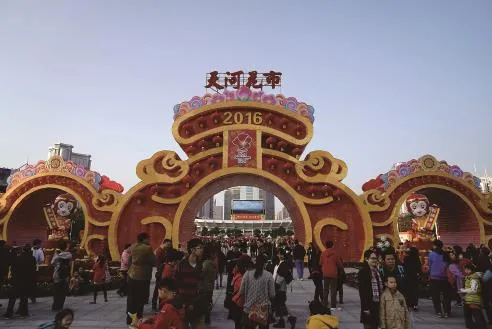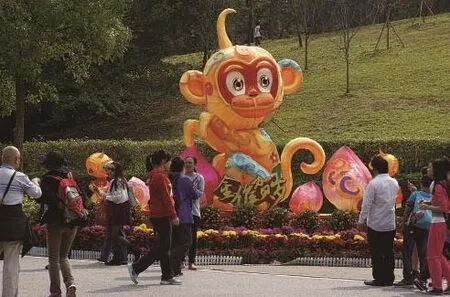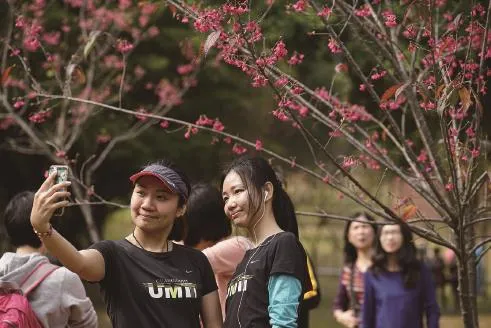THE ClTY OF FLOWERS
2016-04-14TextbyMaYanlingPhotosbyZhengJijun
Text by Ma Yanling Photos by Zheng Jijun
THE ClTY OF FLOWERS
Text by Ma Yanling Photos by Zheng Jijun

The Cantonese get themselves in the festive mood by shopping for flowers and gifts at the flower fairs, which are usually open and ready for business at least three days before the Spring Festival.
At this time of the year, the streets are decorated with flowers and potted tangerines. Florists from different villages set up stalls to sell flowers and tangerines.
The origin of flower fairs dates back at least 500 years ago to the Ming Dynasty. As the earliest trade port in China to be opened on the Silk Road, Guangzhou soon became one of the most blooming cities in China, both in terms of economy and plants, as various kinds of exotic flowers were first imported to Guangzhou at the time.
Ever since then, it has become a major custom for the Cantonese to shop for flowers, potted plants and bouquets as New Year gifts for their family and friends.
For decades, the Flower Fair has been a hot subject for poets and singers. Chinese playwright Du Xuan once described the Flower market as such: “It is the time when the southern early spring sends the fragrance around." Back to the Qing Dynasty, Zhang Xintai wrote in his Shallow Knowledge and Experience in Guangdong, "At the end of each year, the flower market is full of bellflower and daffodil which makes the market as beautiful as the rosy clouds. All the merchants, no matter big or small, provide small tables and seats to welcome the citizens and the blooming year".
Thus, Canton is also called the “city of flowers”, which also originates from the Flower markets themselves. Following the Northern Wei Dynasty (368-534), ikebana - the Japanese art of flower arrangement - was on the rise in China. During this period of time, the country provided a rather peaceful political background for scholars and aristocrats to fully develop their interests in aesthetics, including ikebana.
Nowadays, people buy flowers to wish of good luck. The “year flowers” sold in the flower markets each hold a different significance. For instance, the tangerine represents fortune and luck, since the word tangerine in Chinese is homophonous with the word “good luck”, whilst bamboo stands for "a better career". Lilies are linked with "a harmonious union lasting a hundred years". H
ere is a tip for those who wish to buy flowers at a good price: go by midnight! It is when the prices of the flowers drop dramatically.
For the Cantonese, the sweet perfume of fresh flowers is the perfect reminder of this important custom - “the Flower Fair”, whose importance is emphasized with the saying: “No flower fairs, no Spring Festival.”


百年除夕花市 花开灿烂娱岁华
“年卅晚,行花街,迎春花放满街排,朵朵红花鲜,朵朵黄花大,千朵万朵睇唔哂。阿妈笑,阿爸喜,人欢花靓乐开怀……”这首老广们耳熟能详的儿歌,描写的是一年一度广州人“行花街”赏花买花的风俗。
“行花街”是广州的方言,意指“逛花市”,一般于春节前三四天开始,广州的大街小巷都会摆满鲜花、盆桔,各大公园都举办迎春花展。各区的主题街道上搭起彩楼,搭起花架,四乡花农纷纷涌来,摆开阵势,售花卖桔,所谓“十里长街,繁花似锦”。特别是除夕夜,几乎家家全员出动赏花买花共团圆,摩肩擦踵,好不热闹!
广州有一句古话,“行过花街才是过年”,这项沿袭了百余年的习俗,形成于光绪年间,是广州人过年时不可代替的重要活动!历史上也曾有不少文人学士为迎春花市挥过笔墨,如著名剧作家杜宣就曾这样描述除夕花市:“重裘脱下换春装,南国初春处处香。踏过长街花似锦,人人都为看花忙。”而早在光绪年间,张心泰所写《粤游小识》中说:“每届年暮,广州城内卖吊钟与水仙花成市,如云如霞,大家小户,售供坐几,以娱岁华。”可见广州迎春花市不仅历史悠久,其中的趣味也值得把玩。
实际上,广州的另一雅称“花城”正是源于这迎春花市。而鲜花处处有,为何唯独这南粤省城形成了独特的逛花街风俗呢?

早在北魏之后,花道在中国慢慢兴起,直到宋代,达到了它的鼎盛巅峰。当时国家政局稳定,百姓生活安康,文人雅士们多了很多生活情趣,而插花便是其中之一。据闻当时上至达官贵人,下至普通老百姓,家里都能见到一两瓶花!形态各异的鲜花结合花型、花器和人们丰富的想象力,成了一个个艺术品。爱花历史自古皆有,而广州人天生对“好意头”的追求,为求新年“花开富贵”,能平安富足,以花寓意,因而行花街,也成了一种“沾好运”的象征,故而流传了下来。
买花赏花,不外乎追求的是人们赋予花儿的含义,也就是我们所说的“花语”和“花意”。宋人有“梅兰竹菊”四君子,寓意素雅清净,高洁谦虚的品格;而今有粤人追求“竹报平安”“百年好合”的吉祥花意,连红掌、猪笼草等也顺时应变被命名为“抓钱手”或是“鸿运当头”。尤其是本地的生意人,更不能错过逛花市!买上一两盆好花放在店里,寓意来年生意红红火火,犹如这鲜花般充满活力,所谓“花开灿烂,今年必好生意”!
但如果你只是想买上一两盆便宜的漂亮花,在除夕夜12点左右来逛花市就最合适不过了!到了午夜12时,迎春爆竹声响起后,如果花多客少,花价马上暴跌,这时买花几乎是“半买半送”,所谓“想便就夜来”。
花花世界,繁多盛大!百年除夕花市,绵绵不断的迎春花潮,寓意着人们对美好生活的孜孜追求和期盼,也寓意着人们无论在顺境逆境中,都对未来保持希望和热情,如同这鲜花般,年年岁岁照常开!
